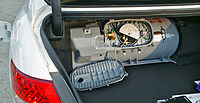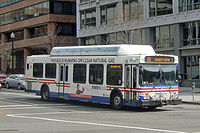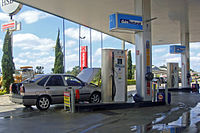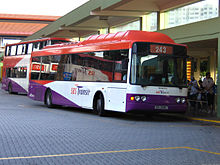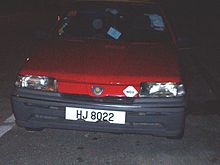- Natural gas vehicle
-
- "NGV" redirects here. For the art gallery in Melbourne, Australia, see National Gallery of Victoria.
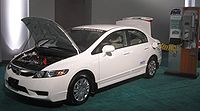 2009 Honda Civic GX hooked up to Phill refueling system.
2009 Honda Civic GX hooked up to Phill refueling system.
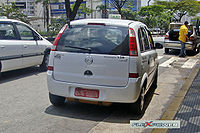 Brazilian flexible-fuel taxi retrofitted to run also as a GNV. The compressed natural gas (CNG) tanks are located underneath the body in the rear.
Brazilian flexible-fuel taxi retrofitted to run also as a GNV. The compressed natural gas (CNG) tanks are located underneath the body in the rear.
A natural gas vehicle or NGV is an alternative fuel vehicle that uses compressed natural gas (CNG) or liquefied natural gas (LNG) as a clean alternative to other fossil fuels. Worldwide, there were 12.7 million natural gas vehicles by 2010, led by Pakistan with 2.7 million, Iran (1.95 million), Argentina (1.9 million), Brazil (1.7 million), and India (1.1 million).[1] The Asia-Pacific region leads the world with 6.8 million NGVs, followed by Latin America with 4.2 million vehicles.[1] In the Latin American region almost 90% of NGVs have bi-fuel engines, allowing these vehicles to run on either gasoline or CNG.[2]
As of 2009, the U.S. had a fleet of 114,270 compressed natural gas (CNG) vehicles, mostly buses; 147,030 vehicles running on liquefied petroleum gas (LPG); and 3,176 vehicles liquefied natural gas (LNG).[3] Other countries where natural gas-powered buses are popular include India, Australia, Argentina, and Germany.[4] In OECD countries there are around 500,000 CNG vehicles.[5] Pakistan's market share of NGVs was 61.1% in 2010, follow by Armenia with 32%, and Bolivia with 20%.[1] The number of NGV refueling stations has also increased, to 18,202 worldwide as of 2010, up 10.2% from the previous year.[1]
Existing gasoline-powered vehicles may be converted to allow the use of CNG or LPG. An increasing number of vehicles worldwide are being manufactured to run on CNG. The Honda Civic GX is the only NGV commercially available in the US market.[6][7], although Ford offers a prep package on certain models. GM do Brasil introduced the MultiPower engine in August 2004 which was capable of using CNG, alcohol and gasoline (E20-E25 blend) as fuel, and it was used in the Chevrolet Astra 2.0 model 2005, aimed at the taxi market.[8][9] In 2006 the Brazilian subsidiary of FIAT introduced the Fiat Siena Tetra fuel, a four-fuel car developed under Magneti Marelli of Fiat Brazil. This automobile can run on natural gas (CNG); 100% ethanol (E100); E20 to E25 gasoline blend, Brazil's mandatory gasoline; and pure gasoline, though no longer available in Brazil it is used in neighboring countries.[10][11]
Despite its advantages, the use of natural gas vehicles faces several limitations, including fuel storage and infrastructure available for delivery and distribution at fueling stations. Natural gas must be stored in cylinders, whether it is CNG (compressed) or LNG (liquefied), and these cylinders are usually located in the vehicle's trunk, reducing the space available for other uses, particularly during long distance travel. This problem can be solved in factory-built CNVs that install the tanks under the body of the vehicle, thanks to a more rational disposition of components, leaving the trunk free. As with other alternative fuels, natural gas distribution to and at fueling stations, as well as the number of stations selling CNG are other barriers for widespread use of NGVs.[5] CNG-powered vehicles are considered to be safer than gasoline-powered vehicles.[12][13][14] CNG may also be mixed with biogas, produced from landfills or wastewater, which doesn't increase the concentration of carbon in the atmosphere.
NGV's can be refueled anywhere from existing natural gas lines. This makes home refuelling stations that tap into such lines possible. A company called FuelMaker pioneered such a system called Phill Home Refueling Appliance (known as "Phill"), which they developed in partnership with Honda for the American GX model.[15][16] Phill is now manufactured and sold by BRC FuelMaker, a division of Fuel Systems Solutions, Inc.[17]
Contents
Differences between LPG and CNG fuels
Though LPG and CNG are both considered NGVs, the technologies are vastly different. Refueling equipment, fuel cost, pumps, tanks, hazards, capital costs are all different. In fact, the two fuels are as different as gasoline, diesel and CNG are. One thing they share is that due to engines made for gasoline, computer controlled valves to control fuel mixtures are required for both of them, often being proprietary and specific to the manufacturer.
LPG as an auto fuel
LPG, or liquified petroleum gas, is a mixture of gasses that stay liquid. It is considerably cheaper than natural gas not only for pumps and storage but also the fuel itself. However, it has drawbacks because it is heavier than air and tends to collect below a vehicle or tank during leaks, which would allow it to ignite explosively upon ignition. Other drawbacks include up to 20 minutes refueling time for a sedan, making refueling inconvenient and queue forming. Automobile crashes of lower speeds rupture and ignite tanks with considerably less force required than for CNG tanks due to their lighter and cheaper designs. (Not a requirement of LPG technology, but an in common use design tradeoff). It is rarely used in developed countries as a transport fuel due to above mentioned drawbacks..
CNG as an auto fuel
CNG, on the other hand, being roughly 50% more expensive than LPG for the fuel itself, also requires higher compression and thus thicker walled tanks, adding to its material cost and weight. Refueling stations are also much more expensive to build than LPG. However, the cost of the fuel itself often is still much cheaper than oil based products; some part of USA as of 2011 sell a gallon's equivalent for less than one dollar. CNG is lighter than air, dispersing upwards making it a far safer fuel than LPG during leaks, as well as far stronger minimum requirements for CNG tanks vs LPG tanks. In fact, CNG tanks made by major automobile manufacturers such as Toyota are designed to withstand 50 mph impact from 1 ton trucks along with release valves to minimize safety concerns. Since tanks are usually in the back of a vehicle, it is very rare but not impossible for impacts to be greater than this, but even in this scenario explosion is not guaranteed as CNG disperses quite rapidly.
Advantages over gasoline and diesel
NGVs and especially CNG tends to corrode and wear the parts of an engine less rapidly than Gasoline. Thus its quite common to find NGV with diesel-engine like mileage, such as over 500,000 miles. Emissions are cleaner, there is generally less wasted fuel, and lower emissions of carbon and lower particulate emissions per equivalent distance traveled. Compared with diesel particulate emissions are like night and day; CNG is hundreds of times cleaner.
Chemical composition and energy content
Chemical composition
The primary component of natural gas is methane (CH4), the shortest and lightest hydrocarbon molecule. It may also contain heavier gaseous hydrocarbons such as ethane (C2H6), propane (C3H8) and butane (C4H10), as well as other gases, in varying amounts. Hydrogen sulfide (H2S) is a common contaminant, which must be removed prior to most uses.
Energy content
Combustion of one cubic meter yields 38 MJ (10.6 kWh). Natural gas has the highest energy/carbon ratio of any fossil fuel, and thus produces less carbon dioxide per unit of energy.
Storage and transport
Typical LPG gas tank located in the trunk.
Transport
The major difficulty in the use of natural gas is transportation. Natural gas pipelines are economical and common on land and across medium-length stretches of water (like Langeled, Interconnector and Trans-Mediterranean Pipeline), but are impractical across large oceans. Liquefied natural gas (LNG) tanker ships, railway tankers, and tank trucks are also used.
Storage
CNG is typically stored in steel or composite containers at high pressure (3000 to 4000 lbf/in2, or 205 to 275 bar). These containers are not typically temperature controlled, but are allowed to stay at local ambient temperature. There are many standards for CNG cylinders, the most popular one is ISO 11439.[18][19] For North America the standard is ANSI NGV-2.
LNG (Liquefied Natural Gas) storage pressures are typically at or just above the local atmospheric pressure (0 to 30 lbf/in2, or 0 to 2.1 bar). LNG is stored at temperatures as low as -260°F (-162°C). At these temperature and pressure conditions, natural gas is in a liquid state. Storage temperatures may vary due to varying composition and storage pressure. LNG is far denser than even the highly compressed state of CNG. As a consequence of the low temperatures, vacuum insulated storage tanks are used to hold LNG. These tanks are often referred to as dewars to credit the early cryogenic scientist Sir James Dewar.
CNG can be stored at lower pressure in a form known as an ANG (Adsorbed Natural Gas) tank at 35 bar (500 psi, the pressure of gas in natural gas pipelines) in various sponge like materials, such as activated carbon[20] and metal-organic frameworks (MOFs).[21] The fuel is stored at similar or greater energy density than CNG. This means that vehicles can be refuelled from the natural gas network without extra gas compression, the fuel tanks can be slimmed down and made of lighter, less strong materials.
Implementation
Natural gas vehicles are popular in regions or countries where natural gas is abundant, where the government chooses to price CNG lower than gasoline.[4] The use of natural gas began in the Po River Valley of Italy in the 1930s, followed by New Zealand in the 1980s, though its use has declined there. At the peak of New Zealand's natural gas use, 10% of the nation's cars were converted, around 110,000 vehicles.[4] In the United States CNG powered buses are the favorite choice of several public transit agencies, with a fleet of more than 114,000 vehicles, mostly buses.[22] India, Australia, Argentina, and Germany also have widespread use of natural gas-powered buses in their public transportation fleets.[4]
Conversion kits
Conversion kits for gasoline or diesel to LPG/CNG are available in many countries, along with the labor to install them. However, the range of prices and quality of conversion vary enormously.
Kits in Thailand for gasoline to LPG can be done with relatively good quality for as little as $1,500 these days, whereas in the USA CNG conversions can run up to $16,000 for a family car. In the early years (2003-2006) Thailand had issues with conversion kit quality as mechanics made many mistakes, however with familiarization quality has greatly improved.
Recently, regulations involving certification of installations in USA have been loosened to include certified private companies, those same kit installations for CNG have fallen to the $6,000+ range (depending on type of vehicle).
North America
United States
As of December 2009, the U.S. had a fleet of 114,270 compressed natural gas (CNG) vehicles, 147,030 vehicles running on liquefied petroleum gas (LPG), and 3,176 vehicles running on liquefied natural gas (LNG).[3] The NGV fleet is made up mostly of transit buses but there are also some government fleet cars and vans, as well as increasing number of corporate trucks replacing diesel versions, most notably Waste Management, Inc and UPS trucks.[citation needed] As of February 2011, there were 873 CNG refueling sites, 2,589 LPG sites, and 40 LNG sites, led by California with 215 CNG refueling stations in operation, 228 LPG sites and 32 LNG sites. The number of refueling stations includes both public and private sites, and not all are available to the public.[3] As of December 2010, the U.S. ranked 6th in the world in terms of number of NGV stations.[1]
Mexico
The natural gas vehicle market is limited to fleet vehicles and other public use vehicles like minibuses in larger cities. However the state-owned bus company RTP Of Mexico City has purchased 30 Hyundai Super Aero City CNG-Propelled buses to integrate with the existing fleet as well as to introduce new routes within the city.
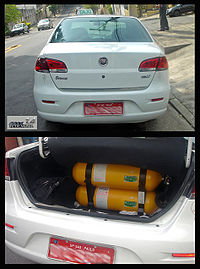 Popular among taxi drivers, the Brazilian Fiat Siena Tetrafuel 1.4, is a multifuel car that runs as a flexible-fuel on pure gasoline, or E20-E25 blend, or pure ethanol (E100); or runs as a bi-fuel with natural gas (CNG). Below: the CNG storage tanks in the trunk.
Popular among taxi drivers, the Brazilian Fiat Siena Tetrafuel 1.4, is a multifuel car that runs as a flexible-fuel on pure gasoline, or E20-E25 blend, or pure ethanol (E100); or runs as a bi-fuel with natural gas (CNG). Below: the CNG storage tanks in the trunk.
South America
CNG vehicles are common in South America, with a 35% share of the worldwide NGV fleet,[1] where these vehicles are mainly used as taxicabs in main cities of Argentina and Brazil. Normally, standard gasoline vehicles are retrofitted in specialized shops, which involve installing the gas cylinder in the trunk and the CNG injection system and electronics.
As of 2009 Argentina had 1,807,186 NGV's with 1,851 refueling stations across the nation,[1] or 15% of all vehicles;[23] and Brazil had 1,632,101 vehicles and 1,704 refueling stations,[1] with a higher concentration in the cities of Rio de Janeiro and São Paulo.[8][23]
Colombia had an NGV fleet of 300,000 vehicles, and 460 refueling stations as of 2009.[1] Bolivia has increased its fleet from 10,000 in 2003 to 121,908 units in 2009, with 128 refueling stations.[1] Peru had 81,024 NGVs and 94 fueling stations as 2009,.[1] In Peru several factory-built CNVs have the tanks installed under the body of the vehicle, leaving the trunk free. Among the models built with this feature are the Fiat Multipla, the new Fiat Panda, the Volkswagen Touran Ecofuel, the Volkswagen Caddy Ecofuel, and the Chevy Taxi. Other countries with significant GNV fleets are Venezuela (15,000) and Chile (8,064) as of 2009.[1]
Latest developments
GM do Brasil introduced the MultiPower engine in August 2004 which was capable of using CNG, alcohol and gasoline as fuel. The GM engine has electronic fuel injection that automatically adjusts to any acceptable fuel configuration. This motor was used in the Chevrolet Astra and was aimed at the taxi market.[8]
In 2006 the Brazilian subsidiary of FIAT introduced the Fiat Siena Tetra fuel, a four-fuel car developed under Magneti Marelli of Fiat Brazil.[10][24] This automobile can run on 100% ethanol (E100), E20 to E25 blend (Brazil's normal ethanol gasoline blend), pure gasoline (not available in Brazil), and natural gas, and switches from the gasoline-ethanol blend to CNG automatically, depending on the power required by road conditions.[25]
Since 2003 and with the commercial success of flex cars in Brazil, another existing option is to retrofit an ethanol flexible-fuel vehicle to add a natural gas tank and the corresponding injection system. Some taxicabs in São Paulo and Rio de Janeiro, Brazil, run on this option, allowing the user to choose among three fuels (E25, E100 and CNG) according to current market prices at the pump. Vehicles with this adaptation are known in Brazil as tri-fuel cars.[26]
South Asia
- Pakistan
Pakistan is currently the country with the largest fleet of NGV with a total of 2.7 million and the world's largest number of NGV refuelling stations with 3,600 as of July 2010. Most of the public transportation fleet has been converted to CNG.[27] However, the vast majority of private vehicles included in the figures run on LPG, which carries inherent fuel ignition risks during refueling, there are many illegal conversions, and there is an effort to switch over to CNG but the costs of not only the modifications to the vehicle, but the fuel itself and station availability and quality of pumps (not up to North American standards) keep the progress slow. Also, in Pakistan and India[28][29], there have been on-going (last several years now) series of CNG/LPG fuel shortages which periodically waxes and wanes, getting the fuel into a tank can be a major problem. In July 2011, petrol usage shot up 15% from the month before due to shortages.[30]
- India
The use of LPG and CNG as a transport fuel was introduced in India, in 1991, when the national exhaust emission standards were issued. In the year of 1993, CNG had become available in Delhi, India's capital, though LPG is what really took off due to its inherently far lower capital costs. Compressed Natural Gas is a domestic energy produced in Western parts of India. In India, most CNG vehicles are dual fueled, which means they can run both on CNG and gasoline. This makes it very convenient and users can drive long distances without worrying about availability of natural gas (as long as gasoline is available). As of December 2010 India had 1,080,000 NGVs and 560 fueling stations, many of the older ones being LPG rather than CNG.[1] In addition, it is thought that more illegally converted LPG autos than legal ones ply the streets in India, some estimates are as high as 15 million "autos" (running the gamut of everything from LPG motored pedal bicycles to CNG buses)[31]
In the year of 1995, a lawyer filed a case with the Supreme Court of India under the Public Interest Litigation rule, which is part of the Constitution of India and enables any citizen to address directly the Supreme Court. The lawyer’s case was about the health risks caused by air pollution emitted from road vehicles. The Supreme Court decided that cars put into circulation after 1995 would have to run on unleaded fuel. By 1998, India was converted to 100% of unleaded fuel after that government ruled that diesel cars in India were restricted to 10,000 ppm after 1995. At the beginning of 2005, 10,300 CNG busses, 55,000 CNG three-wheelers taxis, 5,000 CNG minibuses, 10,000 CNG taxis and 10,000 CNG cars run on India’s roads (1982-2008 Product-Life Institute, Geneva). The Delhi Transport Corporation currently operates the world's largest fleet of CNG buses for public transport.[32]
Southeast Asia
Thailand
Thailand has for over a decade run natural gas taxi cabs in Bangkok.[33] In view of a generous supply of natural gas but relying on imported oil, the Thailand government promoted alternative fuels like natural gas and ethanol to replace gasoline beginning around 2003. A significant effort was taken when the state-controlled oil company PTT PCL built a network of natural gas refueling stations and limited the price of LPG at roughly USD 25 cents a kilogram. The cost of subsidy was estimated at US$150 million in 2008. As price of oil climbed rapidly, it was estimated more than 40,000 cars and trucks powered by natural-gas were converted to or purchased in six months in 2008. About half of the taxi fleet in Bangkok used the fuel. According to an estimate by oil company PTT, about 115,000 vehicles were running on LPG as of 2008, while there were only about 1,000 in 2003. Officials expected natural-gas vehicles, in many cases capable of running both gasoline and natural gas, to almost triple to 330,000 by 2012, many of those being CNG.[34] Since 2008 there has been a government arm-twisting to switch from LPG to CNG, with a rollout of CNG stations near Bangkok around 2007 and then upcountry in 2010, at times replacing LPG stations. Some operators have balked at the conversion cost as well as CNG fuel cost, since CNG costs more than LPG, but CNG is safer during transport and fueling.
Malaysia
In Malaysia, the use of compressed natural gas was originally introduced for taxicabs and airport limousines during the late-1990s, when new taxis were launched with NGV engines (also mostly LPG) while taxicab operators were encouraged to send in existing taxis for full engine conversions, reducing their costs of operation. Any vehicle converted to use CNG is labelled with white rhombus "NGV" (Natural Gas Vehicle) tags, lending to the common use of "NGV" when referring to road vehicles with CNG engine. The practice of using CNG remained largely confined to taxicabs predominantly in the Klang Valley and Penang due to a lack of interest. No incentives were offered for those besides taxicab owners to use CNG engines, while government subsidies on petrol and diesel made conventional road vehicles cheaper to use in the eyes of the consumers. Petronas, Malaysia's state-owned oil company, also monopolises the provision of CNG to road users. As of July 2008[update], Petronas only operates about 150 CNG refueling stations, most of which are concentrated in the Klang Valley. At the same time, another 50 was expected by the end of 2008.[35]
As fuel subsidies were gradually removed in Malaysia starting June 5, 2008, the subsequent 41% price hike on petrol and diesel led to a 500% increase in the number of new CNG tanks installed.[36][37] National car maker Proton considered fitting its Waja, Saga and Persona models with CNG kits from Prins Autogassystemen by the end of 2008,[38] while a local distributor of locally assembled Hyundai cars offers new models with CNG kits.[39] Conversion centres, which also benefited from the rush for lower running costs, also perform partial conversions to existing road vehicles, allowing them to run on both petrol or diesel and CNG with a cost varying between RM3,500 to RM5,000 for passenger cars.[36][40]
Singapore
There were about 400 CNG-fueled vehicles in Singapore in mid-2007, of which about 110 are taxis operated by Smart Automobile. By February 2008, the number has risen 520 CNG vehicles, of which about half are taxis.[41] All vehicles had to refuel at the sole CNG station operated by Sembcorp Gas and located on Jurong Island until the opening of the first publicly accessible CNG station at Mandai in 2008, operated by Smart Automobile.[42] The company plans to build another four stations by 2011, by which time the company projects to operated 3,000 to 4,000 CNG taxies, and with 10,000 CNG public and commercial vehicles of other types on Singapore's roads.[43] Sembcorp Gas opened its second CNG station a week after the Mandai station at Jalan Buroh.[41]
Indonesia
A few vehicles in Indonesia run on LPG, known as Elpiji, despite it being widely available in state controlled Pertamina stations even in rural and far flung parts of Indonesia; it is mainly used as a cooking gas or heating fuel to replace kerosene. CNG is almost unheard of as a transport fuel before 2010 in the archipelago except in Jakarta, where a very relatively minor amount of vehicles, most notably Transjakarta buses, use the fuel. However, since 2010 there has been a government emphasis to push usage of CNG as well as LPG not only for vehicle fuel, but also for domestic consumption over wood burning (can produce deadly methanol) and kerosene.
China
China had 450,000 NGV's and 870 refueling stations as of 2009.[1] China's national reserves was 134 billion cubic meters at the end of 2007.[citation needed]
Iran
As of mid 2011 Iran with 2.6 million[44] NGV fueled vehicles holds the second biggest NGV fueled transportation system in the world after Pakistan[45], and the world's largest number of CNG vehicles.[46] In November 2011, Iran had 1800 operating NGV stations[47] and it is slated to rise to 2100 until 20th March 2012.[48] The NGV system in Iran is supplying 16 million cubic meters of natural gas equivalent of 16 million liters of gasoline per day. Iran’s daily gasoline consumption has decreased following the implementation, of among other measures, the expanding CNG-powered fleet.[49] The original stimulus for the CNG program was the cost of imported gasoline due to insufficient local refining capacity and possibility of sanctions which could restrict imports of gasoline. With its vast natural gas reserves (second in the world after Russia) Iran has no technical limits in natural gas resources in the forseeable future. Iran's large cities have significant pollution issues which could be turned around dramatically with the replacement or conversion of older gasoline and diesel vehicles to run on CNG or dual-fuel. All NGVs in Iran are currently bi-fueled (NGV/gasoline).[50]
See also
- HCNG dispenser
- List of natural gas vehicles
References
- ^ a b c d e f g h i j k l m n "Natural Gas Vehicle Statistics: Summary Data 2010". International Association for Natural Gas Vehicles. http://www.iangv.org/tools-resources/statistics.html. Retrieved 2011-08-02. Click on Summary of 2010 Data and NGVs by Region.
- ^ Pike Research (2011-09-14). "Pike Research predicts 68% jump in global CNG vehicle sales by 2016". AutoblogGreen. http://green.autoblog.com/2011/09/26/pike-research-predicts-68-jump-in-global-cng-vehicle-sales-by-2/#continued. Retrieved 2011-09-26.
- ^ a b c Stacy C. Davis, Susan W. Diegel, and Robert G. Boundy (June 2011). "Transportation Energy Data Book: Edition 30". Office of Energy Efficiency and Renewable Energy, U.S. Department of Energy. http://cta.ornl.gov/data/tedb30/Edition30_Full_Doc.pdf. Retrieved 2011-08-27. See Tables 6.1 and 6.5, pp. 6-3 and 6-8.
- ^ a b c d Sperling, Daniel and Deborah Gordon (2009). Two billion cars: driving toward sustainability. Oxford University Press, New York. pp. 93–94. ISBN 978-0-19-537664-7.
- ^ a b Ryan, Lisa; Turton, Hal (2007). Sustainable Automobile Transport. Edward Elgar Publishing Ltd, England. pp. 40–41. ISBN 978-1847204516.
- ^ Christine Gable and Scott Gable. "2008 Natural Gas Vehicles (NGVs) Available". About.com: Hybrid Cars & Alt Fuels. http://alternativefuels.about.com/od/2008ngvavailable/a/2008CNGvehicles.htm. Retrieved 2008-10-18.
- ^ "2009 Honda Civic GX Natural Gas Vehicle". Honda. http://automobiles.honda.com/civic-gx/. Retrieved 2008-10-18.
- ^ a b c GNVNews (November 2006). "Montadores Investem nos Carros á GNV" (in Portuguese). Institutio Brasileiro de Petroleo e Gas. http://www.bigas.com.br/sistema/?modulo=gnvnews&acao=abrir&id=22. Retrieved 2008-09-20.
- ^ "Astra é líder no segmento dos compactos em 2004: As versões do Chevrolet Astra 2005" (in Portuguese). Journal Express. 2005-01-18. http://www.jornalexpress.com.br/noticias/detalhes.php?id_jornal=9095&id_noticia=1703. Retrieved 2008-10-15. (Portuguese)
- ^ a b Christine Lepisto (2006-08-27). "Fiat Siena Tetra Power: Your Choice of Four Fuels". Treehugger. http://www.treehugger.com/files/2006/08/fiat_sienna_tetr.php. Retrieved 2008-08-24.
- ^ Agência AutoInforme (2006-06-19). "Siena Tetrafuel vai custar R$ 41,9 mil" (in Portuguese). WebMotor. http://www.webmotors.com.br/wmpublicador/Noticias_Conteudo.vxlpub?hnid=36391. Retrieved 2008-08-14.(Portuguese) The article argues that even though Fiat called it tetra fuel, it actually runs on three fuels: natural gas, ethanol, and gasoline, as Brasilian gasoline is an E20 to E25 blend.
- ^ "How Safe are Natural Gas Vehicles?" (PDF). Clean Vehicle Education Foundation. http://www.cleanvehicle.org/committee/technical/PDFs/Web-TC-TechBul2-Safety.pdf. Retrieved 2008-05-08.
- ^ "How Safe is Natural Gas?". http://alternativefuels.about.com/od/naturalgaspropane/a/safenaturalgas.htm. Retrieved 2008-05-08.
- ^ "Fighting CNG fires" (PDF). http://www.firetrainingresources.net/items/CNGAutoFire-FIREFIGHTERNEARMISScompressedpics.pdf. Retrieved 2008-05-08.
- ^ FuelMaker Corporation - World Leader in Convenient On-Site Refueling Systems
- ^ EVWORLD FEATURE: Honda's Phill-way to Hydrogen:HONDA | CNG | NATURAL | GAS | CIVIC | GX | PHILL | ELLIS | HYDROGEN | H2
- ^ "BRC FuelMaker Again Selling Phill Home CNG Fuel Station". http://blogs.edmunds.com/greencaradvisor/2011/03/brc-fuelmaker-again-selling-phill-home-cng-fuel-station.html. Retrieved 2011-04-04.
- ^ Gas cylinders -- High pressure cylinders for the on-board storage of natural gas as a fuel for automotive vehicles
- ^ ISO 11439 Overview and FAQ
- ^ US National Science Foundation (NSF)
- ^ US National Science Foundation (NSF)
- ^ Pike Research (2009-10-19). "Forecast: 17M Natural Gas Vehicles Worldwide by 2015". Green Car Congress. http://www.greencarcongress.com/2009/10/forecast-17m-natural-gas-vehicles-worldwide-by-2015.html#more. Retrieved 2009-10-19.
- ^ a b R. Fernandes (2008-08-20). "Latin America NGVs: An Update Report". International Association of Natural Gas Vehicles. http://www.ngvglobal.com/en/country-reports/latin-america-ngvs-an-update-report-02074.html. Retrieved 2008-10-11.[dead link]
- ^ "Nouvelle Fiat Siena 2008: sans complexe" (in French). Caradisiac. 2007-11-01. http://news.caradisiac.com/Nouvelle-Fiat-Siena-2008-sans-complexe-359. Retrieved 2008-08-31. (French)
- ^ Agência AutoInforme (2006-06-19). "Siena Tetrafuel vai custar R$ 41,9 mil" (in Portuguese). WebMotor. http://www.webmotors.com.br/wmpublicador/Noticias_Conteudo.vxlpub?hnid=36391. Retrieved 2008-08-14. (Portuguese)The article argues that even though Fiat called it tetra fuel, it actually runs on three fuels: natural gas, ethanol, and gasoline.
- ^ TaxiNews. "Gás Natural Veicular" (in Portuguese). TDenavagari.com.br. http://www.devanagari.com.br/taxinews.com.br/pag/noticia_02_resumos.asp?regn=36. Retrieved 2008-08-24. (Portuguese)
- ^ Shahab Ansari (2011-03-10). "CNG cylinders or moving bombs?". International The News. http://www.thenews.com.pk/TodaysPrintDetail.aspx?ID=35323&Cat=5&dt=3/10/2011. Retrieved 2011-04-05.
- ^ "CNG shortage puts auto drivers in a fix". The Hindu (Chennai, India). 2009-11-08. http://www.hindu.com/2009/11/08/stories/2009110859560300.htm.
- ^ http://www.rediff.com/news/slide-show/slide-show-1-gas-shortage-hits-mumbai/20110315.htm
- ^ http://www.dailytimes.com.pk/default.asp?page=2011%5C08%5C12%5Cstory_12-8-2011_pg5_2
- ^ http://info.bellperformance.com/blog/bid/48368/LPG-Fueled-Vehicles-Coming-Soon
- ^ http://www.product-life.org/en/archive/cng-delhi
- ^ [1][dead link]
- ^ Patrick Barta (2008-10-21). "Thais Lead Drive to Natural-Gas Cars". Wall Street Journal. http://online.wsj.com/article/NA_WSJ_PUB:SB122454641299552177.html. Retrieved 2010-08-01.
- ^ "More natural gas stations needed, say motorists". The Star Online. 2008-06-13. http://thestar.com.my/metro/story.asp?file=/2008/6/13/central/21532536. Retrieved 2008-08-04.
- ^ a b Rashvinjeet S. Bedi (2008-06-08). "Motorists rush to check out NGV system". The Star Online. http://thestar.com.my/news/story.asp?file=/2008/6/8/focus/21482211. Retrieved 2008-08-04.
- ^ Vinesh, Derrick (2008-06-25). "Long queue for NGV kits". The Star Online. http://thestar.com.my/metro/story.asp?file=/2008/6/25/north/21635112. Retrieved 2008-08-04.
- ^ "Proton cars to come with NGV kits". The Star Online. 2008-06-28. http://thestar.com.my/news/story.asp?file=/2008/6/28/nation/21685753. Retrieved 2008-08-04.
- ^ Elaine Ang and Leong Hung Yee (2008-07-07). "Moving towards hybrid vehicles". The Star Online. http://biz.thestar.com.my/news/story.asp?file=/2008/7/7/business/21712982. Retrieved 2008-08-04.
- ^ Perumal, Elan (2008-06-13). "Rush to fit natural gas gadget". The Star Online. http://thestar.com.my/metro/story.asp?file=/2008/6/13/central/21532553. Retrieved 2008-08-04.
- ^ a b 404 - NGV Global - Alternative Fuel, CNG, NGV, LNG
- ^ Channelnewsasia.com
- ^ Daryl Loo (July 12, 2007). "Singapore's first public CNG station to be ready by Jan 2008". channelnewsasia.com. http://www.channelnewsasia.com/stories/singaporelocalnews/view/287780/1/.html. Retrieved October 21, 2011.
- ^ http://shana.ir/179344-en.html
- ^ http://www.shana.ir/158124-en.html
- ^ http://www.frost.com/prod/servlet/press-release.pag?docid=210599659
- ^ http://shana.ir/179344-en.html
- ^ http://www.shana.ir/172776-en.html
- ^ http://www.shana.ir/169546-en.html
- ^ http://www.ngvglobal.com/iranian-cng-program-at-crossroads-1020
External links
- CNG Blog
- CNG Forum
- CNG-NGV Community Forum
- CNG Users Site
- CNG Vehicle Information
- DOE-Natural Gas Vehicle Availability
- Greener Cities International project dedicated to the development of an ever growing demand for environmentally friendly eco-sustainable vehicles, specifically to promote the use of cleaner fuels such as CNG and Biogas.
- Natural Gas Vehicle Information
Europe
- The Italian community of Natural Gas Vehicles Forum, technical info, maps also in English, German, and French.
- What is Compressed Natural Gas?
- US Department of Energy Consumers' Guide
- Boost for natural gas cars: Home fueling
Alternative fuel vehicles Compressed-air engine Electric motor Battery electric vehicle · Electric aircraft · Electric bicycle · Electric boat · Electric car · Electric vehicle · Electric motorcycles and scooters · Hybrid electric vehicle · Motorized bicycle · Neighborhood Electric Vehicle · Plug-in electric vehicle · Plug-in hybrid electric vehicle · Solar vehicle · Wind-powered vehicleBiofuel ICE Hydrogen Fuel cell vehicle · Hydrogen economy · Hydrogen vehicle · Hydrogen internal combustion engine vehicleOthers Autogas · Hybrid electric vehicle · Liquid nitrogen vehicle · Natural gas vehicle · Propane · Steam car · Wood gasMultiple-fuel Documentaries See also Categories:- Natural gas vehicles
- Green vehicles
Wikimedia Foundation. 2010.


